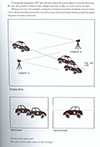Task 1:
Response
Overview
Prior Knowledge
Blog
Task 2:
Investigation
Task 3:
Production
Task 1:
Investigation
Task 2:
Response
Task 3:
Photo Essay Production
Home
Task 1 - Media Art (3A) : Response
Respond to the following statement:
"The films 'Run Lola Run' and ‘The Tree of Life’ are not typical Hollywood films - some would consider them to be examples of media art"
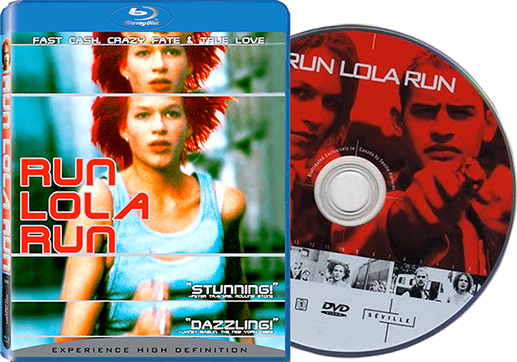
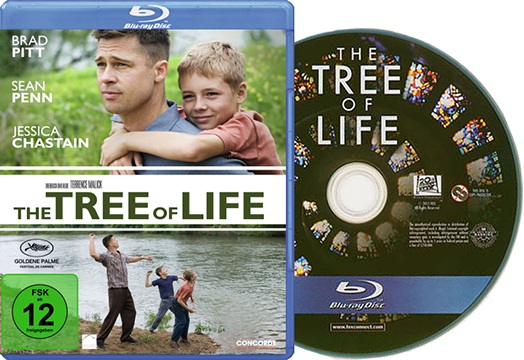
3000 words (Marks will be deducted if outside this word limit – 10% variance on word limit is allowed)
Respond giving specific reasons as to why or why not you agree with this statement (use the following as headings if helpful).
- What is Media Art? (Frame your argument in your introduction discussing some key differences between independent films and commercial films).
- Compare and analyse a common theme established within both films. What specific techniques (codes and conventions) were used in each film to establish this shared theme? How might these techniques and an understanding of their aesthetic impact make them innovative and artistic?
- Are these techniques associated with any historic film movements? Why would the producer have made these links?
- Discuss the narrative structure of the films (Is it a conventional narrative structure? Discuss this referring to other films as well).
- Discuss the controls and constraints placed on the films (discuss how these may have shaped the film).
- Summary and closing argument.
For best results try following these steps:
Step 1 - Watch the films (more than once)
Make sure you take as many notes as you can in your visual diary!!
Step 2 - Collect Information
Make notes, considering:
particular codes and conventions used
narrative elements
representations and/or stereotypes
What past films/styles/movements influenced the film?
note: outcomes 1 and 3 are relevant to this section
Step 3 - Analyse and Interpret
Using your notes, analyse how meaning has been constructed, considering:
why the particular codes and conventions were used in the film
how representations and values appeal to specific audiences
possible alternative readings of the film
constraints that could have impacted on the production of the film
how the cultural context could have affected the film
note: outcomes 3 and 4 are relevant to this section
Step 4 - Reflect and Conclude
Based on your research reflect and conclude your thoughts on why or why not you consider "Run Lola Run" to be an example of media art. note: outcomes 3 and 4 are relevant to this section
SUPPORTING DOCUMENTSInterviews and quotes from the director Tom Tywker Previous Students thoughts on Media ArtVertigo Film trailer featuring spiral referencesMichael K on 'What is Art'? NARRATIVE RESOURCESNarrative Structure Lesson Click here for Lola Narrative Activities Click here for an excellent read on conventional narrative Click here for an interesting read on alternative narratives Click here for a comparision of classical and alternative narrative
Keep in mind the framework for critical analysis!
Remember that the film, it's cultural context, and the audience are all interrelated and work together to construct meaning in media works. The media producers intended meanings must be filtered through the cultural context and reinterpreted by the viewer who brings their own unique experiences and values to the text.
- Preferred meanings constructed in texts: Interpret the meanings constructed by narrative elements, codes and conventions, and the values or point of view evident in representations or stereotypes.
- Cultural context and meaning: Analyse factors within the cultural context that influence the production process, the media stories and how they are told, eg. historical events, social trends, political issues.
- Audiences and meaning: Analyse how audiences bring their own unique experiences and values to the text to help make meaning of it.
Prior Knowledge
Having chosen to participate in the Media Production and Analysis course of study, it is assumed that you have had some Media Studies training in lower school. If you haven't done any previous study in the Media area, you will have a little catching up to do. This isn't a huge ordeal, and with a little commitment, you will find you have caught up on your peers and are well able to engage intelligently with the upper school course - learning how media works, and getting creative!
The tabs below will give you some introductory information that you will need to be familiar with, including a few short exercises to get you up to speed.
Some examples of past students work: Student Video Archives
Framing & Composition
Continuity and the 180 degree rule
Juxtaposition
Every form of communication has some kind of basic grammar, or rules, to make communication more efficient and affective. Many of today's televisions still make use of 4x3 screen dimensions but this is quickly changing to 16:9 wide screen. As such in our shooting context we will be using 16:9 wide screen as this soon will be the standard in Australian television. Considered use of framing, composition and camera angles within this context will greatly assist communication - increasing your viewers' pleasure.
Here are a few guidelines that you should consider before you press the record button on your camera. Make sure you're confident about recording quality images before you start using up your tape.
Framing
- When framing people, you should generally put their eye-level about two thirds of the way up the screen.
- In medium shots, leave a little headroom - space between the top of the head and the edge of the TV screen.
- If the person you're shooting is looking off-screen (not directly into the camera) make sure you leave some 'nose-room', or 'talking space'.
Rule of Thirds
Horizontal lines, like the horizon, can look boring if you place them in the centre of the screen. They look much better one third fom the top or bottom. The same applies for vertical lines - put vertical objects one third in from the left or right of the screen. If you divide your screen into thirds, both vertically and horizontally, the four intersecting points are 'points of interest' where the eye is naturally drawn. Consider these 'sweet-spots' when framing up.
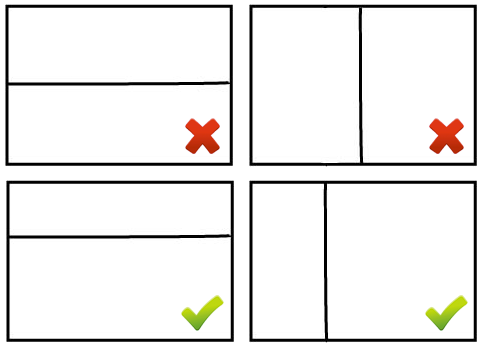
Camera Angles
Eye-Level Shot: The camera is horizontal to the ground. In a wide or mid-shot, the camera should be at the eye-height of an unseen observer. With closer shots, the camera should be at the eye-level of the subject being filmed.
High-Angle Shot: Where the camera is higher than the subject being filmed, and tilted down. These shots make the subject look inferior, weak or powerless; making the viewer seem powerful or superior.
Low-Angle Shot: The camera is lower than the subject and tilted upwards. This angle makes the subject appear powerful, strong or superior.
Jump-Cuts
Jump cuts happen when two shots similar in composition and framing, and of the same subject, are cut together. It can be very disconcerting for your viewer, and can look very silly.
To avoid jump-cuts, make sure the framing of the subject is substantially different between shots if they are of the same subject. You can do this by moving the camera closer or further away from the subject, zooming in or out, or movng the camera to a different angle (from front on, to a half-profile shot). Where you DO have two shots that are very similar, you can hide it by using a cut-away or cut-in.
Click on each of the pictures down the right hand side of the screen. Make sure you understand them fully before you take a camera out to complete this exercise.
The 180 Degree Rule
When you are shooting any scene, you will need to follow the 180 degree rule for your scene to make sense. If you don't follow this essential rule, your scene will not look continuous.
The first step in following the rule is to establish the 'line of communication'. Once this imaginary line is drawn, all shots are taken from one side or the other, but NEVER do you shoot from BOTH sides of the line. Click here for a great web page that illustrates this idea.
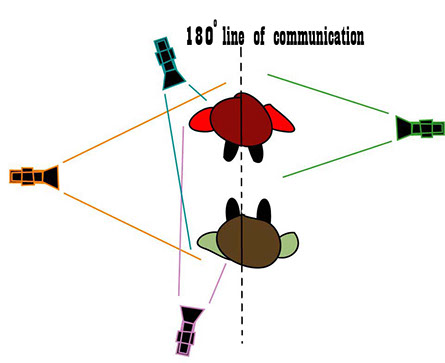
In the above scene, the orange, purple and blue cameras will all edit together well. The green camera is the wrong side of the line, and will cause problems in editing.
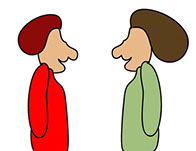



Click the thumbnail below and read it. When you're confident that you understand continuity and the 180 degree rule, do the continuity exercise.
Juxtaposition
Juxtapose means to place things side by side to create meaning.
Juxtaposition in film is used by film makers to create meaning in the audience's mind by positioning different shots next to one another. If the two images are not commonly put together then it forces the viewer to stop and work out what it means. Often, when juxtaposition is used in this way, a complete break in terms of time, space and subject is common, with images being used to stimulate the viewer emotionally and intellectually. For example, a woman being administered an injection could be inter cut with images of a vicious dog snarling. The dog may have nothing to do with the woman, the drugs or medication, but adds valuable meaning to the sequence.
Example:
1. Flower and Dog:
Initial reaction - Violence and fear.
Considered response - Sometimes things aren't always as they seem at first glance. Flower could be poisonous.

Blog - Level Indicators
Your blog is a very important part of your major assessment for semester two. It will be used to document your thoughts and your planning for your documentary film that you will be producing this semester. It will not replace your visual diary, but will instead be used as an overview of your progress throughout pre-production, production, and post-production. The importance of thorough research for documentary film cannot be overstated, and your blog will help keep you motivated and disciplined as you investigate your topic.
You are expected (as a minimum) to spend the first ten minutes of every class making a new blog entry. It should contain a brief overview of where you are at in terms of your research for your documentary, citing any references and linking to relevant articles and documents pertaining to the subject of your film. It will also serve as a production and post-production journal where you will discuss your progress through each stage of the film making process.
Please take this discipline seriously as it is a major component of your assessment and if you get slack with it - it is not something you will be able to catch up with at the last minute (the journal entries are dated!). It is your responsibility to be continually adding to your blog and making it an integral part of your media studies through to the end of the year.
Your blog should contain basic logging of things you have learned and decisions you have made, but should also refer often to the outcomes that you are trying to satisfy at a high level. In order to help you with this, you should make sure you address one aspect of one outcome each week until you have addressed them all. This means that you will have a whole week to satisfy just one aspect, in order to cover all the theoretical outcomes by the end of the semester.
To help you with this, copy and paste the appropriate aspect and level into your website. Focus on this to ensure a thorough completion of the course at the level you wish to achieve.
Week 1 - 3 | Responses to MediaWeek 1Outcome 3 Aspect 1 - understand how meaning is constructed in media works.Level 3 - understand how common codes and conventions communicate meaning in predictable stories with stereotypical characters.Level 4 - understand how codes and conventions are used to construct meanings, representations and values in familiar media works.Level 5 - understand how codes and conventions are selected to create preferred meanings, particular representations and points of view in media works from different cultural contexts. Looking at media from different time or places, understand how all the media elements have been put in place to give particular meanings.Level 6 - understand how the selection of codes and conventions constructs representations and points of view about people and issues that connect to cultural values. Understand the way stars, stereotypes and heroesare presented tell us about what the culture values.Level 7 - understand how the selection of codes and conventions, representations , viewpoints and values construct levels of meaning in complex media works. Analyse the different levels on which a film, etc, can be interpreted and explain how all the media elements work to produce those meanings.Level 8 - understand how codes and conventions are tools used to construct and deconstruct meanings, values and viewpoints in media representations and works. Week 2Outcome 3 Aspect 2 - understand interrelationships between media works, cultural contexts and audiences.Level 3 - understand that media works are created within a cultural context and that audiences have different expectations of media works.Level 4 - understand that media works are influenced by the cultural context, and how audience readings and expectations of media works are influenced by their cultural experiences. Understand that the place and time we live in influences the media produced and how we interpret it.Level 5 - understand that different media works appeal to audiences in different contexts, and that cultural factors influence the reading of media works. Understand that people in different times and places enjoyed different media to what we might and that the time and place a person lives in influencesLevel 6 - understand that media works, cultural context and audience are interrelated and that a range of cultural factors shapes the readings of alternative media works. Understand that where and when it was made and who it was made for influenceshow we interpret the film, etc.Level 7 - understand how the cultural context impacts on the production of media works and on the readings of those works by mainstream and sub-cultural audiences. Note how concerns of the time and place influenced the production of the film, etc, and how different audiences interpret.Level 8 - understand how media works, cultural contexts and audiences are related to values and ideologies when making meaning of media works. Week 3Outcome 3 Aspect 3 - use strategies to investigate and comment on media works and evaluate media productions.Level 3 - express their opinion on media works and their production processes.Level 4 - use given criteria to investigate and express their opinions on media works, and to reflect on their production processes. Follow teacher instructions to express ideas about media products.Level 5 - choose a strategy to investigate and express opinions on media works, and to reflect on the suitability of particular choices during production. When analysing films, etc, if you use a chart, write an essay or report, give lots of suitable examples and explain how effective they are.Level 6 - use investigative processes, frameworks and appropriate media language and structure to analyse media works, present ideas and evaluate productions, considering effects of alternative approaches. When analysing films, etc, use media terminology and look at different ways of doing things as well.Level 7 - use formal processes of critical analysis to investigate and justify interpretations of media works, communicate opinions and evaluate productions, considering audience responses. Use recognised academic theories and practices to analyse films, etc.Level 8 - draw from a range of strategies to investigate and critically evaluate extended challenging media works, communicate opinions and evaluate productions, considering purpose, the impact of specific choices and appeal to intended audience or client.Week 4 - 6 | Media in SocietyWeek 4Outcome 4 Aspect 1 - draw from a range of strategies to investigate and critically evaluate extended challenging media works, communicate opinions and evaluate productions, considering purpose, the impact of specific choices and appeal to intended audience or client.Level 3 - understand the impact of technological developments on their lifestyle, and the effect of common controls and constraints on their use of media.Level 4 - understand technologies have impacted on media production and audiences, and how a defined range of controls and constraints influences media production and use. Note technology used in making and experiencing media products and how given examples of controls affect the media.Level 5 - understand increased personal and global use of technologies has impacted on society, and how a defined range of controls and constraints shapes media production and use. Note how you use technology personally and how big global companies impact the world, and how the media has to abide by financial, government and legal controls.Level 6 - understand technologies developed for different purposes and markets bring about change in society, and how a range of controls and constraints impacts on media production and use. Note the changes in society that bring about and come from the use of new technologies and how financial, government and legal controls affect media.Level 7 - understand the impact of technologies and globilisation on local, national and international media audiences, and a range of external controls and constraints on media practices. Understand how global companies affect what audiences see and how constraints affect how media products are made.Level 8 - understand the impact on producers and audiences of emerging technologies, and constraints imposed by economic imperatives, government policies, institutional controls and lobby groups on media practices. Week 5Outcome 4 Aspect 2 - • understand the influence of social, historical and cultural contexts on media production and use.Level 3 - understand the influence of media on their knowledge of world events.Level 4 - understand media contribute to their lifestyle and culture, and how familiar media works reflect the cultural context in which they were produced. Notice ways media is present in our lives and how films, etc, reflect the time and place they were made.Level 5 - understand the influence of historical events and cultural trends on media production and use, and economic and cultural benefits of a range of media works. Notice actual historic events and how people function in society reflected in films, etc, and how much films, etc, can be about making money and/or art.Level 6 - understand the media shape aspirations and perceptions of the world, and how social, historical and/or political events bring about changes in media production and use. Understand how we view the world is influenced by the media and how events in society are reflected in films, etc, and how people use the media.Level 7 - understand ideologies in particular cultural contexts impact on media production and use, and how perceptions of history are shaped by the media. Understand political beliefs influence films, etc, and that the media is powerful in influencing public opinion about past events.Level 8 - understand the influence of shared ideologies on past and contemporary media production and use, and how alternative histories might have been constructed. Week 6Outcome 4 Aspect 3 - • understand how cultural values are influenced by the media and in turn influence media production.Level 3 - understand how values depicted in media characters and stories relate to personal values. and the values of their family and friends.Level 4 - understand how values in popular media reinforce mainstream cultural values, and in turn influence the form and content of media works. Understand popular media promotes values important to society.Level 5 - understand how cultural values are reinforced by media personalities, and in turn, the values of cultural and sub-cultural groups influence roles in media production. Understand that popular stars and heroes reflect what society and subcultures believe in.Level 6 - understand how the values of dominant and sub-cultural groups are reinforced by media representations, and in turn, values, attitudes and beliefs influence media production. Understand how society’s values are seen in stars and stereotypes which continue to be reproduced in the media.Level 7 - understand how cultural values are challenged and/or reinforced by popular and alternative media works, and in turn, values of dominant and sub-cultural groups influence in media productions.Powerful groups with an agenda can influence through the media and reinforce or change how people think.Level 8 - understand how media contributes to changes in values and attitudes, and in turn, social trends and public opinion are reflected in the media.Week 7 - 9 | Media IdeasWeek 7Outcome 1 Aspect 1 - • understand how media communicate ideas in particular contexts and for different audiences and purposes.Level 3 - understand main features of media forms and recognise that different forms appeal to different audiences.Level 4 - understand how different media forms communicate ideas to familiar audiences in their culture. Explain how the message gets across to the audience.Level 5 - understand how media forms from past and contemporary cultural contexts communicate ideas to different audiences. Recognise how different media forms and media products connect to audiences in different time periods and cultures.Level 6 - understand how media forms from different cultural contexts communicate ideas that connect to audiences and accommodate their values and expectations. Understand how films, etc, from different times or places have ideas and values which their target audiences relate to.Level 7 - understand how particular media forms and styles communicate ideas that reinforce or challenge audience values. Recognise some media products will be accepted by the mainstream audience and note how other forms challenge what the audience believes in.Level 8 - understand how alternative and avant-garde media styles and forms communicate ideologies and impact on audiences or clients. Week 8Outcome 1 Aspect 2 - • explore technologies, codes and conventions to create meaning and develop ideas.Level 3 - explore, through structured activities, a limited range of technologies, codes and conventions to create meaning and develop ideas based on personal experiences.Level 4 - explore technologies, common codes and narrative conventions to create meaning and develop ideas that reflect shared experiences. Use S.W.A.T. codes and ways we expect stories to be told to create messages.Level 5 - explore functional and aesthetic use of technologies, codes and narrative conventions to create meaning and develop ideas that draw from past and contemporary media works. Use professional media works for inspiration and explore both straightforward and more unusual ways of presenting ideas.Level 6 - evaluate and adapt technologies, narrative structures, codes and conventions to create meaning and develop ideas that reflect different cultural contexts. Choose and use ways of telling the story that show influences from other times or places or styles.Level 7 - experiment with technologies, codes and conventions to create meaning, integrating ideas drawn from research to express opinions, values or viewpoints that reflect different cultural contexts. Conduct various production experiments and research media from a wide range of times and placesand use this to inform the ideas in your media product.Level 8 - show a personal style, drawing from extensive research and experimenting with technologies, codes and conventions, to express values and viewpoints that reflect or challenge particular ideologies. Week 9Outcome 1 Aspect 3 - • present ideas, designs and/or production plans.Level 3 - present ideas in simple scripts and plans, using text or drawings, and show how ideas might be realised.Level 4 - create and present simple scripts, plans and design proposals to show how ideas will be realised. Make sure your ideas comes across clearly in your plan and storyboard.Level 5 - create and present scripts, plans and design proposals and indicate how particular options will cater for purpose and audience. Show how your script/plan is suitable for your target audience and end screening target.Level 6 - create and present detailed scripts, plans and design proposals that show the development of ideas, and the merits of different options for particular purposes and audiences. Present pros/cons for target audiences and screening target for each idea covered, and all expected paperwork associated with the task.Level 7 - create detailed scripts, plans and design proposals that include the results of audience research, evaluation of choices and acknowledgement of values that influenced decisions. Research your target audience’s values and then create scripts and plans showing how you have incorporated that in the choices you’ve made.Level 8 - create detailed scripts, plans and design proposals that elaborate ideas, purpose and audience, and acknowledge the values, aesthetics and ethical decisions underpinning their ideas.Week 10 - 15 | Maintain logging as a Production JournalContinue to maintain logging as a Production Journal
Task 2 - Media Art (3A) : Investigation
One major goal of this course is to give students the skills to analyse media texts effectively. In a year twelve stage three unit the expectation of your written skills are very high, and as such insightful analysis skills are paramount.
This task is designed to give you a framework that you will be able to use in all your written work, and serve as preparation for your exams (you will sit 3 major exams this year).
For this task you will receive stimulus material (article, text, or video clip) and a question. You will have a week to investigate and research the question and stimulus topic (the topic will relate to an aspect of the course that we have already studied or are in the process of studying).
You will then be given 40 minutes in class (under exam conditions) to complete a written response to the question (notes are allowed) and then you will cross mark another students work. Finally the work will be handed to your teacher for final grading. You will complete a total of 5 of these in class writing exercises which will take place at the end of term 1 and start of term 2. This will result in strengthened writing skills for the exam and a stockpile of exam revision notes that you will be able to share amongst your peer group.
This is a major component of the course (20% of unit) so make sure you are in class the day the written work is to take place (otherwise alternative times - ie lunch - will have to be organised with your teacher).
For the diligent student (and we would encourage all of you to do this!) you may read ahead to future week's question's and begin your thought planning well in advance to the assessment day (click links below to download).
Investigation Task Part 1 (NARRATIVE)
Explain how the narrative of a Media Art film can break the conventions and audience expectations typically found in mainstream films.
Stimulus - 'Formal Expectations' Article and 'Memento' clip
Investigation Task Part 2 (EMERGING TECHNOLOGY)
Discuss how advances in technology are affecting the way both Independent and Commercial film producers are finding ways to deliver their messages.
Stimulus: New York Times January 17 2010 Just Sell it Yourself
New Directions for Independent Cinema:
Investigation: Task Part 3 (CONTROLS AND CONSTRAINTS)
Investigation: Task Part 4 (MEDIA ART RECAP)
Stimulus: View opening Scene of Amelie
Task 3 - Media Art (3A) : Production
In this production task you will be creating your own 'media art works'. This work will be produced in groups of three, and exceptional pieces will be published on the Swan Media web page (and hopefully win you awards and recognition outside the school as well!). This production will also be submitted to the Curriculum Council for external marking, and will make up 45% of your external grade for this course.
IT IS THEREFORE ONE OF THE MOST IMPORTANT TASKS OF THE YEAR SO GIVE IT YOUR BEST!
For more information on the external production submission process click the links to the right.
FORMSEquipment Loan Form Talent Release Form Music Permission FormEXTERNAL PRODUCTION SUBMISSION INFORMATIONOfficial Information regarding external submission 2012 Sample External submission marking key Sample Student External Submission Paper Work 1
PAST STUDENT MEDIA PRODUCTIONS
The Winner of the Tafe Media Review Awards and the WASA 2009 from Presbyterian Ladies College:
You have a lot of freedom to be creative, but your production should have the following characteristics:
- Must be a short piece (no longer than 5 minutes due to external submission requirements) that manipulates codes, challenges conventions, and appeals to non-mainstream audiences.
- Use a non-realist narrative that uses stylistic techniques found in short film, animation, and music videos.
- Incorporate different technologies and art forms. (click here for example and here)
- Must have an underlying message and theme - don't be so ambiguous that your production becomes meaningless! (Click here for an example)
- Have strong evidence of planning and pre-production such as brainstorming notes in your visual diaries, a production schedule/run-sheet, a written treatment, script, storyboards, and other relevant documentation (i.e. release forms, permission to use music etc)
Outcomes 1 and 2 will be the focus for this assessment.
In order to complete this task successfully, you will need to develop and follow a plan to ensure that you understand the processes involved, and achieve all the relevant outcomes. This will require you to keep a record of your production as it progresses in your visual diary.
THIS DOCUMENTATION IS A VERY IMPORTANT PART OF YOUR ASSESSMENT - PLEASE STAY ON TOP OF IT!
For some ideas on how to develop your plan please follow the following steps:
STEP 1 | Developing Ideas about Media Art (Outcome 1)
- Find out various opinions about 'media' and 'art'. Weigh up these opinions and make your own conclusions about what constitutes media art.
- Investigate a range of media forms. Consider different styles of photography, film, TV, radio, podcasting, comics, animation, posters, and web sites. Before deciding on the form you will uses for your production, think about your own preferences, skills, and interests and how you might extend your skills and creativity. Also think about your audience and how you might tap into their interests, attitudes, and values.
- Investigate specific styles or genres used by producers in that medium. This will involve you analysing the media language used by producers, for example, how they construct their narratives; the ways they create and manipulate meaning through the selection of codes, conventions and representations; the points of view and/or values that characterise their work.
- Experiment with technologies and some of the codes and conventions you have investigated. Work out how you can use aesthetic codes, for example, choosing and manipulating lighting, using colour or black and white, framing shots to portray a particular mood or feeling; positioning the audience to connect with your message; using montage to manipulate time or handle multiple plots; selecting and manipulating audio and/or written codes.
- Find out various opinions about 'media' and 'art'. Weigh up these opinions and make your own conclusions about what constitutes media art.
STEP 2 | Presenting Ideas & Planning
- Draw up your design proposal, script/treatment, story boards, layouts and/or designs. This step will help you articulate exactly how you will be putting your project together. Keep all these planning documents in your visual diary.
- Allocate team roles and responsibilities, prepare a production schedule, organise costumes and props, and book any necessary equipment.
STEP 3 | Production (Outcome 2)
- Apply technologies, skills, and processes to records images, audio, text and graphics appropriate to your media form.
- Fulfill all team roles and responsibilities assigned to you.
- Use information, codes, and conventions and representations according to plans.
- Consider the controls and constraints that operate in your school and the community.
- At the end of each production session, jot down your thoughts in your visual diary, and think about the things you could improve next session.
STEP 4 | Post-Production (Outcome 2)
- Apply your editing and compositing skills as you assemble your project in premiere pro and after affects.
- Plan, promote and present your exhibition screening or broadcast. This will involve compressing the video for broadcast over the Internet.
STEP 3 | Evaluation
This step should be easy if you have kept up with your visual diary!
Some things to consider in your evaluation:
- What you selected: how particular choices strengthened your message or impact of your production
- What you deliberately left out: give reasons for not using particular footage, interviews, techniques.
- How successful were you in reaching your target audience? How they responded, whether they accepted your intended meaning or interpreted it differently.
- Constraints: consider how you coped with problems that arose - time constraints, school rules, team expertise, individual responsibilities, ethical issues, and audience values.
- How successful were you in achieving your goals: does the production meet your expectations of 'media art'?
Task 1 - Power & Persuasion (3B) : Investigation
Your investigation task will be completed in the form of an online journal in conjunction with your production task for the remainder of the year.
Your blog is a very important part of your major assessment for semester two. It will be used to document your thoughts and your planning for your documentary film that you will be producing this semester. It will not replace your visual diary, but will instead be used as an overview and record of your progress throughout pre-production, production, and post-production. The importance of thorough research for documentary film cannot be overstated, and your blog will help keep you motivated and disciplined as you investigate your topic.
In order to help you with this, you should make sure you address one aspect of each outcome every week until you have addressed them all. This means that you will have a whole week to satisfy just one aspect, in order to cover all the theoretical outcomes by the end of the semester. Each week you will need to produce a substantial entry (approx 400 words) that relates to the specific aspect taken from the course outcomes (ie in week 1’s entry you must demonstrate you ‘understand how meaning is constructed in media works.’ - ie You might choose to discuss Michael Moore and how he creates meaning through specific conventions in his films).
To help you with this, copy and paste the appropriate aspect and level into your blog each week - and aim to write at least 400 words on each aspect (ie total of approx 3500 words by the end of the task).
IMPORTANT NOTE!
Please take this discipline seriously as it is a major component of your assessment and if you get slack with it - it is not something you will be able to catch up with at the last minute (the journal entries are dated!). It is your responsibility to be continually adding to your blog and making it an integral part of your media studies through to the end of the year.
CLICK THE BLOG TAB (right column) TO SEE THE TOPIC YOU SHOULD BE DISCUSSING IN YOUR BLOG EACH WEEK!
Task 2 - Power & Persuasion (3B) : Response
For this task we will view the documentary Kony 2012 by Invisible Children (Directed by Jason Russell)
PART A (15 marks)
Discuss the techniques Invisible Children use to put forward a powerful and persuasive argument in the film Kony 2012. Explain in detail how the film attempts to connect with the audience and make a powerful impact, using the following points as a guide:
- Examine specific techniques used to promote Invisible Children's political agenda
- Discuss how Russell's awareness of the cultural context at the time of production is used to connect with and challenge audience values and attitudes
- Discuss the impact of current trends in technology on both the creation and distribution of Kony 2012
PART B (15 marks)
Kony 2012 Screening Met with Anger in Northern Uganda
Why you should feel awkward about the Kony 2012 Video
After reading the articles above discuss how we as intelligent and responsible viewers should approach and engage with media texts such as Kony 2012. Use the following points as a guide:
- Discuss possible ethical issues Russell faced when producing this film
- Discuss how groups of people are represented and analyse any stereotypes that are used in the film
- Discuss why so many resistant readings have emerged since the release of the film
Be sure to conclude your essay with your thoughts and feelings on the film and whether or not you believe it is a powerful and persuasive media text.
- MAXIMUM 3000 WORDS
- Your response for this task is to be in essay format with references cited (refer to diary for referencing guide)
Keep in mind the framework for critical analysis!
Remember that the text, it's cultural context, and audience are all interrelated and work together to construct meaning in media works. The media producers intended meanings must be filtered through the cultural context and reinterpreted by the viewer who brings their own unique experiences and values to the text.
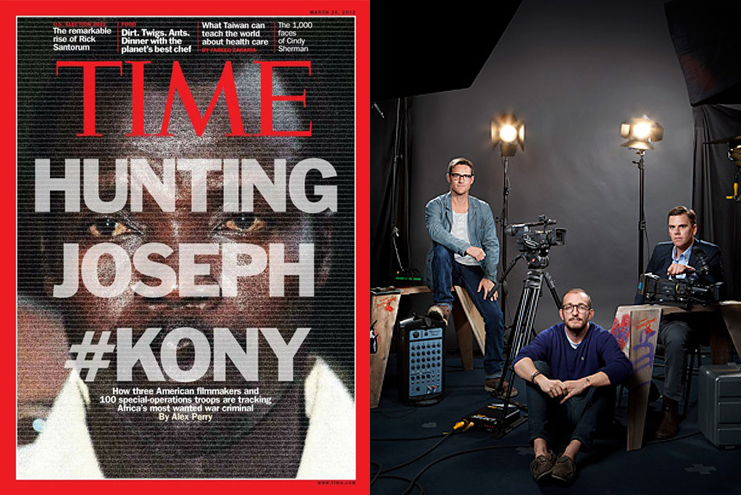
Web Links:
Invisible Children Youtube Channel
Task 3 - Power & Persuasion (3B) - Photo Essay Production
In this production task you are to produce a powerful photo essay (8-10 still images). This task is an individual production and exceptional pieces will be featured on the Swan Media Highlight Page.
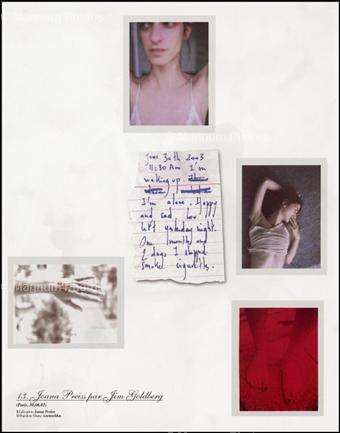
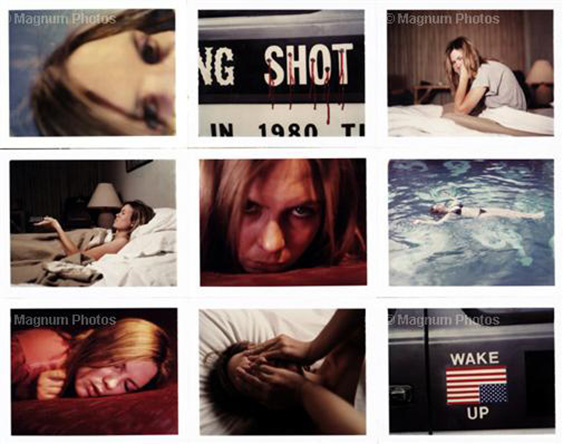
Some examples of what you could produce are as follows:
- A photo essay that presents a point of view about an issue, event or sub-cultural group of people.
- A photo essay that challenges established values, attitudes, ideologies (ie you could make a photo essay questioning materialism in our western society).
- A persuasive piece that creates awareness about issues of such as domestic violence, racism, unemployment, abuse, mental health, marginalised people groups, discrimination (racial, religious, age, sex, physical ability etc).
For full task description click here
Click here for equipment loan forms
To get some creative ideas started click here!
Download ken's composition tips click here (creating the 3rd dimension)
You will need to submit:
- Your planning and design proposal
- Written research and rationale
- Finished production (8-10 images printed or slide show)
- Journal entries (6 total)
- Self Evaluation
SOME PRACTICAL STEPS
In order to achieve this task successfully you will need to develop a strong plan which you will lay out in your written research and journal entries. The steps will be very similar to the planning you will have undertaken in Unit 3A's production task. For some great tips on how you should practically do this read the following steps:
STEP 1 : Developing Ideas about Media Art (Outcome 1 and Outcome 3)
- Brainstorm ideas considering possible themes, topics, media forms and target audience.
- Research your idea/issue referring to relevant organisations, government institutions, personal contacts. Begin to collate your information and resources as you start to formulate a persuasive argument or point of view.
- Investigate specific photographers that are effective in putting forward powerful and persuasive messages. Critically deconstruct their work to see how the photographer has managed to put together such a compelling series of images. This will involve you analysing the media language used by the photographer, for example, how they construct their narratives; the ways they create and manipulate meaning through the selection of codes, conventions and representations; the selection and omission of information, and the points of view and/or values that characterise their work. View as many examples as possible, and make notes of specific styles and techniques used that are effective in portraying a powerful message. Start to think about your audience and how you might connect with them and challenge their attitudes and values.
- Experiment with technologies and some of the codes and conventions you have investigated. Work out how you can involve your audience through techniques such as composition and framing of images, juxtaposition of images, lighting, using colour or black and white, mode of address (how you position the audience to connect with your message), montage and written codes.
STEP 2 : Presenting Ideas & Planning
- Draw up your design proposal, story boards, layouts and/or designs. This step will help you articulate exactly how you will be piecing your project together.
- Prepare a production schedule, organise subjects, and book any necessary equipment.
STEP 3 - Production (Outcome 2)
- Apply technologies, skills, and processes to photograph images.
- Consider the controls and constraints that operate in your school and the community. This is particularly important if you are exploring sensitive and controversial topics.
- At the end of each production session, jot down your thoughts in your visual diary, and think about the things you could improve next session.
STEP 4 - Post-Production (outcome 2)
- Apply your editing and compositing skills as you assemble your project in photoshop. The editing process will be integral in shaping a strong and coherent argument that is both powerful and persuasive.
- Plan, promote and present your exhibition screening or broadcast. This will involve creating a presentation with your photographs.
STEP 5 - Evaluation (outcome 3)
This step should be easy if you have kept up with your journals and research!
Some things to consider in your evaluation:
- What you selected: how particular choices strengthened your message or impact of your production.
- What you deliberately left out: give reasons for not using particular photos/for cropping etc..
- How successful were you in reaching your target audience? How they responded, whether they accepted your intended meaning or interpreted it differently.
- Constraints: consider how you coped with problems that arose - time constraints, school rules, team expertise, individual responsibilities, ethical issues, and audience values.
- How successful were you in achieving your goals: was your final product as powerful and persuasive as you had hoped?
Semester 1
Semester 2
Semester 1 - Unit 3A 'Media Art' (16 weeks)
This course is designed to take your media production & analysis skills to an all new level. Unit 3A offers an in depth study of 'Media Art Forms' that will give you opportunities to investigate and respond to the media in a critical and sophisticated way. Within the media art forms focus, there is a range of interesting learning contexts that will allow you to explore past and present styles and forms that are (or were) considered to be innovative. These forms may have had an impact on society at the time they were produced, they may have challenged existing forms or they may have provided a catalyst that led to the development of new forms and styles.
In this unit you will build upon the knowledge and skills that you have developed in previous media units. This course will also provide you with many opportunities to further develop your production skills through a wide array of engaging production tasks, covering various media forms. The focus on media art forms will give you the opportunity to experiment and stamp your own personal style on the media works you produce.
We'll be working on three major tasks, two of which will be productions and the third a written or oral presentation. After completing Unit 2B last year, you will be aware that there is a huge amount of work and organisation that goes into any successful media production. Make sure you manage your time well, and choose interesting subjects and topics to help you enjoy the fact that you will NEED TO SPEND TIME OUTSIDE OF CLASS WORKING ON YOUR MAJOR TASKS. This site outlines everything you will need to complete this course successfully & should be used in conjunction with your visual diary, course outline & class notes.
Video Examples:
Please note: it is imperative that we have all assignments completed by the due dates in order to complete this unit of study, so please ensure you are on task and that you discuss with your teacher any and all difficulties you may be having.
Before you start anything!
As a media student you will have special privileges which you need to work responsibly with. You will have access to the mac lab which will have a different workflow from which you might be used to.
- The computer you work at on day 1 is the computer you will stay at throughout the whole year - THIS IS VERY IMPORTANT!
- You will keep all your personal media related work on the local drive of that computer in the documents folder.
- You will have access to a 'shared folder' (student shared) where you can swap SMALL files for group work. In exceptional cases you might need to transport large video files to another computer, this will be done using the class external drive (ask your teacher for this).
- NOTE: Be sure to back up all important documents onto your own personal storage device (ie external drive)
NOTE - Any careless behaviour with this equipment will be severely reprimanded and could result in you being removed from this class permanently!
Setting Up
Semester 2 - Unit 3B (15 Weeks)
CLICK HERE FOR 2014 EXAM REVISION PAGE
The focus for this semester is 'Power and Persuasion'. All media products seek to be persuasive in one way or another. Behind every production the producer will always have an intended purpose and meaning. This could be as simple as trying to persuade you to buy a certain brand of toothpaste in a commercial, trying to 'inform' you of current events on the nightly news, or trying to convince you to engage in a movie narrative on an emotional level.
Typically we associate the topic of 'power and persuasion' to non-fiction mediums such as documentary films, which are not ashamed of pushing certain points of view. These films make no secret about wanting to persuade us, for example Al Gore's 'An Inconvenient Truth' or Michael Moore's 'Fahrenheit 911'. Although we will focus on texts such as these in this unit, we will not limit the discussion to non-fiction. We will also acknowledge and discuss how fictional media can also be a powerful medium for presenting new ideas and persuading the audience. I'm sure you can think of some fictional films which impacted you in a powerful way, enabling you to see issues from a completely new angle. For example, two films which helped solidify my beliefs on the death penalty were 'Dead Man Walking' and 'Capote'. Both films powerfully challenge the viewer to re-evaluate whether or not we have the right to take someone else's life.
We will focus on the issue of 'Power and Persuasion' through the lens of the units three essential content areas:
- How the media text was created and it's intended purpose (MEDIA LANGUAGE)
- The cultural context in which the production was made (PRODUCTION)
- How people receive and ultimately make meaning of a media text (AUDIENCE)
We will explore these issues through an investigation task, a response task, and a production task. Once again your visual diary will be an essential tool during this unit so make sure you are continually writing down your thoughts and plans throughout the unit. Your visual diary will not only serve as a valuable tool as you prepare for the exam - it provides evidence that you can plan effectively and think in reflective and critical ways for assessment purposes. For a weekly topic to help you refelect upon in your visual diaries click here (if you are disciplined with this you will effectively be building outcome specific skills that will help you achieve higher levels in this course).
Semester 1
Semester 2
 Swan Christian College - Media Department
Swan Christian College - Media DepartmentSITE MAP
MEDIA TEAM
©COPYRIGHT - SWAN CHRISTIAN COLLEGE 2017
CONTACT

